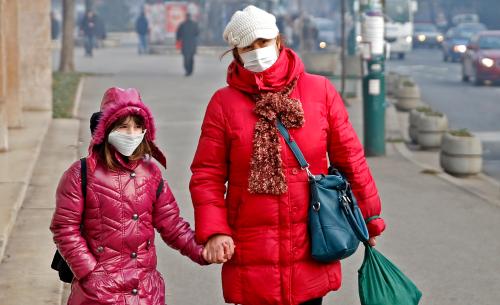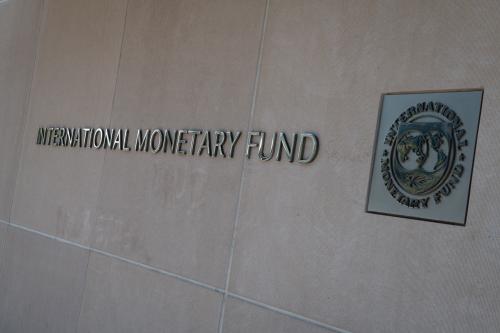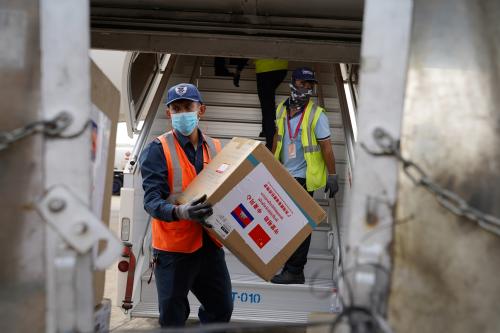In a piece written for this blog four years ago—after the Ebola outbreaks but mostly focused on rising natural disasters—I argued that to deal with global public “bads” such as climate change, natural disasters, diseases, and financial crises, we needed global financing mechanisms. Today, the world faces not just another global public bad, but one that is downright ugly. COVID-19’s stealth, speed of transmission, and high fatality rate make it one of the biggest threats the world has faced in a long time. The case for global financing mechanisms is even stronger.
But in a more divided world, global collective action is proving more difficult. Even the ad hoc and temporary global coordination the world witnessed in response to the Great Recession of 2008-09 is completely absent this time. At that time, the Group of Twenty (G-20) came together to provide a coordinated set of monetary and fiscal stimuli, reaching trillions of dollars, to get the world out of a deep recession. At the International Monetary Fund, a modest SDR (Special Drawing Right) 189 billion issue was agreed upon to try and help developing countries, and it helped. World leaders understood that they had to “hang together or, most assuredly, they will hang separately.”
With the pandemic, despite its worldwide spread, global cooperation is strikingly absent. China and the United States continue to compete for global leadership. The trade war between them is on hold for now—but they are busy trading charges on the pandemic. The U.K. is exiting from the EU, maybe even without a trade deal. Solidarity within the EU is being tested, threatening its very existence. Russia and Saudi Arabia unleashed an oil price war—just as the pandemic was peaking—and a shaky deal prodded by the U.S,. hangs by a thread.
Global forums such as the G-20, which should be at the forefront of a coordinated global response to the pandemic, seem unable to take strong decisive actions. A virtual G-20 meeting announced a $5 trillion response but this figure was just the cumulative total of what each government is planning to do internally. Two weeks later, the G-20 announced a moratorium on debt payments by low-income countries until the end of the year. This is too little. Most of them will need debt write-offs, not payment delays.
The recent IMF-World Bank spring meetings were an opportunity to do more for the developing world. But they were a missed opportunity. The IMF and World Bank have promised large sums of money—$1 trillion and $160 billion, respectively—but these will have to be borrowed. The IMF has had to use its Catastrophe Containment and Relief Trust (CCRT) to pay debts owed to it by developing countries. The World Bank is unwilling to defer debt repayments as it has no similar fund with which to repay itself. The World Bank’s Catastrophe Bonds have just been triggered but with embarrassing delays despite such a huge pandemic. The U.N.’s World Health Organization (WHO), which some have found wanting in even recognizing the dangers, has its funding from its largest contributor, the U.S., put on hold.
The developed world has huge fiscal firepower to deal with the economic catastrophe. But, as it did with the Spanish flu of 1918, the developing world may experience greater loss of life and livelihood, as they do not have the fiscal resources or the health systems to deal with the pandemic. Many people live on daily wages and countries cannot lockdown for too long without facing massive social unrest.
Capital outflows—exceeding $150 billion in the last month alone—are adding to problems for many developing countries by weakening their currencies and restricting their domestic macroeconomic options. Even countries with strong reserve holdings and windfalls from declining oil prices have seen currency declines against the U.S. dollar of 5 to 10 percent, and some as high as 15 to 20 percent. Swap arrangements have helped some countries but these are bilateral.
In my earlier blog post, I proposed four options for global collective action: a global carbon tax, a Tobin tax, a polluter tax on shipping and air travel, and an SDR issue at the IMF. At least two of those should be acted upon now: one to deal with health systems and social safety nets, and another to deal with economic fallout.
The first is a global carbon tax. Global prices of oil and natural gas have crashed. This will be an opportune time to have a small tax on global oil and gas consumption, whose revenues will be set aside in a global fund to help fight the pandemic in the developing world. The funds could be used to provide medical equipment, testing systems, and income support and help to small and medium enterprises. With global consumption at around 35 billion barrels per year in 2019 but likely to drop in 2020, a tax of $5 per barrel would add up to approximately $150 billion. A similar small tax on coal as well as on natural gas, where prices have crashed to below $2 per MMBtu, could raise another $50 billion, reaching $200 billion. The exact amounts for each fuel source could be calibrated based on carbon content and collected at the point of sale.
Such a fund could be administered by an international organization like the World Bank, which has the infrastructure to manage such a special COVID-19 fund and where the rich countries hold controlling votes. As the president of the G-20 and a major oil producer, Saudi Arabia could take the lead on this. It would be its lasting and memorable leadership in this unusual emergency. It would help show OPEC as a force for good—not just a price cartel. It would also be to OPEC’s long-term benefit. It would bolster global recovery, and help oil prices climb back up to $50 per barrel by 2021-22. Such a global carbon tax would also ensure a greener global recovery.
The second option is to allow the IMF to make a special SDR issue of about SDR 475 billion (around $650 billion), which would be allocated to countries based on their quotas. This is equal to the size of the existing quotas at the IMF. Given trade and capital flows each amounting to around $20 trillion, this is a small increase in global liquidity. The IMF’s existing quota, estimated at $1 trillion, mostly has to be borrowed under IMF arrangements, whereas the SDR issuance would be available to countries without IMF conditionality.
Many middle-income countries are afraid to go the IMF, given its past record, for standby arrangements. It erred badly in the Asian financial crisis—when it focused on fiscal contraction—in a crisis largely caused by excessive capital flows to countries that had prematurely liberalized their capital accounts. The IMF must show greater flexibility this time and listen to a wider range of opinions in designing its COVID-19 responses. This crisis is in any case different from a typical financial crisis. The advisory body set up by the IMF’s managing director is a good start—but only if its advice affects what gets put together in the trenches.
The IMF’s World Economic Outlook compared the projected decline in world GDP to the Great Depression. Former Fed chair Ben Bernanke, an expert on the Great Depression, does not think that is an apt comparison, as the depression lasted 12 years. He may well be right as a strong global recovery is possible once a cure and a vaccine are identified. But even if the recovery in GDP and stock markets is quick, the recovery in lives and livelihoods for large sections of the population could be quite slow as we saw after the Great Recession of 2008. And if the world goes back to festering trade wars, increased military spending, and conflict, the global recovery could be much weaker.
The world must use this opportunity to fund global public goods and rebuild global systems to fight the right battles—not to fight each other. At this moment—in the midst of this crisis—a $200 billion COVID-19 Response Fund managed by the World Bank and a 475 billion SDR ($650 billion) special issue at the IMF would go a long way to help developing countries deal with this ugly pandemic.







Commentary
Global solutions to global ‘bads’: 2 practical proposals to help developing countries deal with the COVID-19 pandemic
April 22, 2020